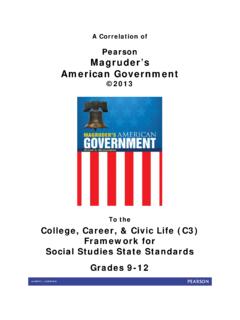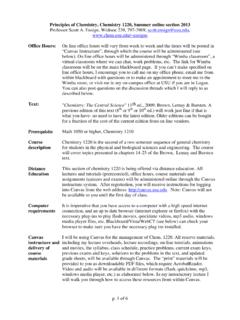Transcription of A Correlation Between the AP Chemistry Curriculum ...
1 1 Pearson Education Brown, LeMay, Bursten Chemistry : The central Science, 12th Edition, AP* Ediiton A Correlation Between the AP Chemistry Curriculum Framework 2013 2014 and Pearson s Brown, LeMay, Bursten Chemistry : The central Science, 12th Edition, AP* Edition The AP Curriculum Beginning with the 2013-2014 school year, the AP Curriculum has been separated into six big ideas. Each big idea is broken into enduring understandings and points of essential knowledge. Under these, learning objectives identify what students should know and be able to do. Each learning objective is further linked to one or more of the science practices. Big Idea 1 The chemical elements are fundamental building materials of matter, and all matter can be understood in terms of arrangements of atoms.
2 These atoms retain their identity in chemical reactions. Learning Objective Science Practice Chapter/ Section The student can justify the observation that the ratio of the masses of the constituent elements in any pure sample of that compound is always identical on the basis of the atomic molecular theory. The student is able to select and apply mathematical routines to mass data to identify or infer the composition of pure substances and/or mixtures. , The student is able to select and apply mathematical relationships to mass data in order to justify a claim regarding the identity and/or estimated purity of a substance. , The student is able to connect the number of particles, moles, mass, and volume of substances to one another, both qualitatively and quantitatively.
3 The student is able to explain the distribution of electrons in an atom or ion based upon data. , , The student is able to analyze data relating to electron energies for patterns and relationships. The student is able to describe the electronic structure of the atom, using PES data, ionization energy data, and/or Coulomb s Law to construct explanations of how the energies of electrons within shells in atoms vary. , , , See notes The student is able to explain the distribution of electrons using Coulomb s Law to analyze measured energies. The student is able to predict and/or justify trends in atomic properties based on location on the periodic table and/or the shell model. , , 2 Pearson Education Brown, LeMay, Bursten Chemistry : The central Science, 12th Edition, AP* Ediiton Students can justify with evidence the arrangement of the periodic table and can apply periodic properties to chemical reactivity.
4 , The student can analyze data, based on periodicity and the properties of binary compounds, to identify patterns and generate hypotheses related to the molecular design of compounds for which data are not supplied. , , , , The student is able to explain why a given set of data suggests, or does not suggest, the need to refine the atomic model from a classical shell model with the quantum mechanical model. , , , , Given information about a particular model of the atom, the student is able to determine if the model is consistent with specified evidence. , , , , The student is able to use data from mass spectrometry to identify the elements and the masses of individual atoms of a specific element.
5 [ , The student can justify the selection of a particular type of spectroscopy to measure properties associated with vibrational or electronic motions of molecules. The student can design and/or interpret the results of an experiment regarding the absorption of light to determine the concentration of an absorbing species in a solution. , , pp564 , The student is able to express the law of conservation of mass quantitatively and qualitatively using symbolic representations and particulate drawings. The student is able to apply conservation of atoms to the rearrangement of atoms in various processes. , The student can design, and/or interpret data from, an experiment that uses gravimetric analysis to determine the concentration of an analyte in a solution.]
6 , , The student can design, and/or interpret data from, an experiment that uses titration to determine the concentration of an analyte in a solution. , , Notes: = Chapter 3 . Section 1; pp564 = page 564; = problem ; = Table 3 Pearson Education Brown, LeMay, Bursten Chemistry : The central Science, 12th Edition, AP* Ediiton Big Idea 2 Chemical and physical properties of materials can be explained by the structure and rearrangement of atoms, ions, molecules and the forces Between them. Learning Objective Science Practice Chapter/ Section Students can predict properties of substances based on their chemical formulas, and provide explanations of their properties based on particle views.
7 , , , The student is able to explain the relative strengths of acids and bases based on molecular structure, interparticle forces, and solution equilibrium. , , , The student is able to use aspects of particulate models ( , particle spacing, motion, and forces of attraction) to reason about observed differences Between solid and liquid phases and among solid and liquid materials. , to The student is able to use KMT and concepts of intermolecular forces to make predictions about the macroscopic properties of gases, including both ideal and nonideal behaviors. , , , , , The student is able to refine multiple representations of a sample of matter in the gas phase to accurately represent the effect of changes in macroscopic properties on the sample.
8 , , , The student can apply mathematical relationships or estimation to determine macroscopic variables for ideal gases. , , , , The student is able to explain how solutes can be separated by chromatography based on intermolecular interactions. The student can draw and/or interpret representations of solutions that show the interactions Between the solute and solvent. , , , , The student is able to create or interpret representations that link the concept of molarity with particle views of solutions. , , The student can design and/or interpret the results of a separation experiment (filtration, paper chromatography, column chromatography, or distillation) in terms of the relative strength of interactions among and Between the components.
9 , The student is able to explain the trends in properties and/or predict properties of samples consisting of particles with no permanent dipole on the basis of London dispersion forces. , The student can qualitatively analyze data regarding real gases to identify deviations from ideal behavior and relate these to molecular interactions. , The student is able to describe the relationships Between the structural features of polar molecules and the forces of attraction Between the particles. , , 4 Pearson Education Brown, LeMay, Bursten Chemistry : The central Science, 12th Edition, AP* Ediiton The student is able to apply Coulomb s Law qualitatively (including using representations) to describe the interactions of ions, and the attractions Between ions and solvents to explain the factors that contribute to the solubility of ionic compounds.
10 , The student is able to explain observations regarding the solubility of ionic solids and molecules in water and other solvents on the basis of particle views that include intermolecular interactions and entropic effects. , , The student is able to explain the properties (phase, vapor pressure, viscosity, etc.) of small and large molecular compounds in terms of the strengths and types of intermolecular forces. The student can predict the type of bonding present Between two atoms in a binary compound based on position in the periodic table and the electronegativity of the elements. , The student is able to rank and justify the ranking of bond polarity on the basis of the locations of the bonded atoms in the periodic table.















